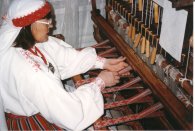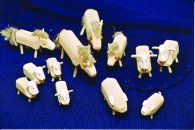Vestnorden Arts & Crafts 2004
Participating countries: |
|||






Estonia

Until the last quarter of the 19th century handicraft was the main source to obtain tools and utensils, everyday and festive clothing and other everyday objects in Estonia. Handicraft making had its certain rhythm and division of labour. For example weaving and all preparation work, sewing and taking care of clothing were left to women whilst leather, wood and metal work to men. The order of labour depended on the season and even on the weekday, work results depended on development of tools and techniques and also on traditions, beliefs and customs.
Today, Estonian Folk Art and Craft Union is the main developer of traditional handicraft. Their aim today is the valuation, preservation and development of national handicraft traditions, taking into account regional features, maintaining folk craft as a cultural phenomenon as well as a source of subsistence. The union has branches in every county cooperating with schools and museums. The Handicraft Union organises various workshops and since 2003 issues a folk-art and craft master certificate. The Union also organises annual handicraft fairs amd every year handicraft masters and associations meet in different parts of Estonia for annual Handicraft Days where they get acquainted with local traditions and handicraft. Exceptional results in developing traditional handicraft are awarded annually with the Heritage Keeper prize.
Successful co-operation with other handicraft organisations in Europe gives the Estonian crafts people strength to look for their roots and with the help of national art and traditions create contemporary high- quality items of handicraft to wear and use with pride and also to introduce to a wider international public.
Participants: |
|||
| Maiken Mundi | Traditional handicrafts | ||
| Liivi Soova | Traditional handicrafts | ||
| AireVolt | Traditional handicrafts | ||


